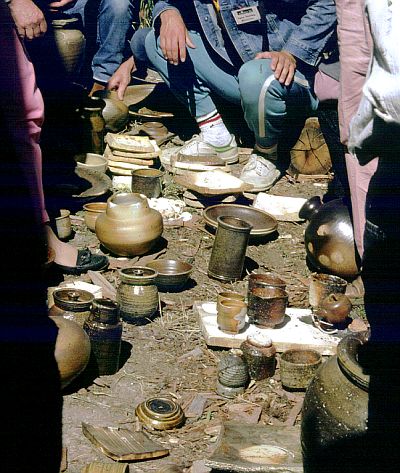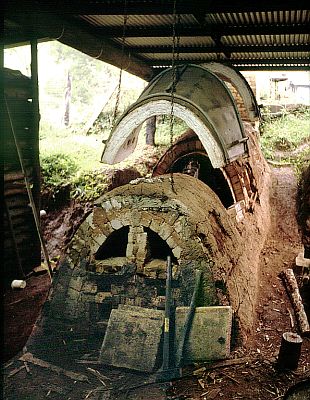|
|
Controlled Reduced CoolingArticle by Arthur Rosser |
| This
is a version of a talk given by Arthur Rosser at the
Sturt Woodfire conference 2008 at Mittagong, NSW. A method of
executing a period of reduction during the cooling of an anagama is
advocated. Carol and Arthur Rosser believe this technique partly
suppresses the ubiquitous mid-brown colours of long wood-firings, while
at the same time encouraging red blushes and some black
colours
while not having a bad effect on shino colours and celedon-like ash
effects. The technique will certainly not be wholly effective on all
clays and with ash effects from all woods. In the hope that it may have
more than local use Arthur encourages other long wood-firers to try it,
and report the results, whether positive or negative, so that a body of
knowledge can be accumulated. An oxygen probe and a pyrometer would be
neeeded for the test. To distinguish this reduced cooling method from others it is convenient to call it Rosser Reduced Cooling |
 |
These are some of the
pots from
the first anagama kiln opening that Carol and I ever saw. The
occasion was the first Australian woodfire conference in Victoria in
1986. We were there in our capacity as woodfire salt glaze
potters, and had no idea until then that some Australian potters were stoking kilns
for days on end to achieve purely natural ash effects. We were not
impressed by these results, which seemed to us to be largely plain
brown, and resolved never to be tempted to do anything as ridiculous as
THAT. In the following years, and at succeeding woodfire conferences, we saw more anagama openings. Some produced good work, but the preponderence of brown pots was usually there. However, in the exhibitions accompanying the conferences we saw really lovely work, and gradually we were persuaded that it was essential to give it a go. We were also aware that anagama firers frequently used a mixture of woods, and thought that we might have more success by firing with just one or two species of wood in each firing. Nearly a decade later we had built and had the first firing of our own anagama. We were disappointed, but not surprised, to see once more an outbreak of the dreaded mid-browns, as you can see from the image below. |
| Worse, the effect seemed to recur with ash from quite different species of wood. The pots on the left of the column of bricks in this image were subjected to ash from Carribean Pine (Pinus carribea) and those on the right were fired with a totally different wood: Forest Red Gum (Eucalyptus tereticornis). This separation of ash was achieved with an experimental kiln arrangement. The kiln has liftable fibre lined access lids so that the two thirds of the chamber nearest the firebox can be packed fully from outside the kiln. This in turn meant that the firebox and two thirds of the chamber could be split in two with a dividing wall. The image is taken looking towards the firebox at the point where the divided chambers meet. The draft ensures that that the twin flame paths, and hence the fly ash, do not mix until a little further towards the exit flues. |  This firing was
under heavy
reduction, followed by periods of more neutral or
oxidising conditions to
ennable temperature rise. When we were satisfied that we had reached a
high enough temperature for long enough we employed Final Stage Reduction followed
by natural cooling.
|
 |
Left: the split anagama. This kiln is also shown here on this site. |